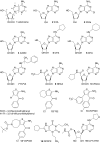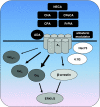Functional selectivity of adenosine receptor ligands
- PMID: 21544511
- PMCID: PMC3146648
- DOI: 10.1007/s11302-011-9232-0
Functional selectivity of adenosine receptor ligands
Abstract
Adenosine receptors are plasma membrane proteins that transduce an extracellular signal into the interior of the cell. Basically every mammalian cell expresses at least one of the four adenosine receptor subtypes. Recent insight in signal transduction cascades teaches us that the current classification of receptor ligands into agonists, antagonists, and inverse agonists relies very much on the experimental setup that was used. Upon activation of the receptors by the ubiquitous endogenous ligand adenosine they engage classical G protein-mediated pathways, resulting in production of second messengers and activation of kinases. Besides this well-described G protein-mediated signaling pathway, adenosine receptors activate scaffold proteins such as β-arrestins. Using innovative and sensitive experimental tools, it has been possible to detect ligands that preferentially stimulate the β-arrestin pathway over the G protein-mediated signal transduction route, or vice versa. This phenomenon is referred to as functional selectivity or biased signaling and implies that an antagonist for one pathway may be a full agonist for the other signaling route. Functional selectivity makes it necessary to redefine the functional properties of currently used adenosine receptor ligands and opens possibilities for new and more selective ligands. This review focuses on the current knowledge of functionally selective adenosine receptor ligands and on G protein-independent signaling of adenosine receptors through scaffold proteins.
Figures







Similar articles
-
Arylpiperazine agonists of the serotonin 5-HT1A receptor preferentially activate cAMP signaling versus recruitment of β-arrestin-2.Bioorg Med Chem. 2015 Aug 1;23(15):4824-4830. doi: 10.1016/j.bmc.2015.05.042. Epub 2015 Jun 1. Bioorg Med Chem. 2015. PMID: 26081758
-
Analysis of functional selectivity through G protein-dependent and -independent signaling pathways at the adrenergic α(2C) receptor.Brain Res Bull. 2014 Aug;107:89-101. doi: 10.1016/j.brainresbull.2014.07.005. Epub 2014 Jul 29. Brain Res Bull. 2014. PMID: 25080296
-
Functional selectivity of adenosine A1 receptor ligands?Purinergic Signal. 2013 Mar;9(1):91-100. doi: 10.1007/s11302-012-9334-3. Epub 2012 Sep 28. Purinergic Signal. 2013. PMID: 23054444 Free PMC article.
-
Biased agonism at the parathyroid hormone receptor: a demonstration of functional selectivity in bone metabolism.Mini Rev Med Chem. 2012 Aug;12(9):856-65. doi: 10.2174/138955712800959125. Mini Rev Med Chem. 2012. PMID: 22681253 Review.
-
Beta-arrestin biased agonism/antagonism at cardiovascular seven transmembrane-spanning receptors.Curr Pharm Des. 2012;18(2):192-8. doi: 10.2174/138161212799040475. Curr Pharm Des. 2012. PMID: 22229558 Review.
Cited by
-
Adenosine A1 receptor regulates osteoclast formation by altering TRAF6/TAK1 signaling.Purinergic Signal. 2012 Jun;8(2):327-37. doi: 10.1007/s11302-012-9292-9. Epub 2012 Feb 5. Purinergic Signal. 2012. PMID: 22311477 Free PMC article.
-
Exploring Adenosine Receptor Ligands: Potential Role in the Treatment of Cardiovascular Diseases.Molecules. 2017 Jun 1;22(6):917. doi: 10.3390/molecules22060917. Molecules. 2017. PMID: 28587166 Free PMC article. Review.
-
Probing biased/partial agonism at the G protein-coupled A(2B) adenosine receptor.Biochem Pharmacol. 2014 Aug 1;90(3):297-306. doi: 10.1016/j.bcp.2014.05.008. Epub 2014 May 20. Biochem Pharmacol. 2014. PMID: 24853985 Free PMC article.
-
The flexibility of SABRE, a new quantitative receptor function model, when fitting challenging concentration-effect data.Front Pharmacol. 2025 Jun 12;16:1591761. doi: 10.3389/fphar.2025.1591761. eCollection 2025. Front Pharmacol. 2025. PMID: 40575783 Free PMC article.
-
Tissue-nonspecific alkaline phosphatase acts redundantly with PAP and NT5E to generate adenosine in the dorsal spinal cord.J Neurosci. 2013 Jul 3;33(27):11314-22. doi: 10.1523/JNEUROSCI.0133-13.2013. J Neurosci. 2013. PMID: 23825434 Free PMC article.
References
-
- Kristiansen K. Molecular mechanisms of ligand binding, signaling, and regulation within the superfamily of G-protein-coupled receptors: molecular modeling and mutagenesis approaches to receptor structure and function. Pharmacol Ther. 2004;103(1):21–80. - PubMed
-
- Oakley RH, Laporte SA, Holt JA, Caron MG, Barak LS. Differential affinities of visual arrestin, βarrestin1, and βarrestin2 for G protein-coupled receptors delineate two major classes of receptors. J Biol Chem. 2000;275(22):17201–17210. - PubMed
LinkOut - more resources
Full Text Sources
Other Literature Sources

